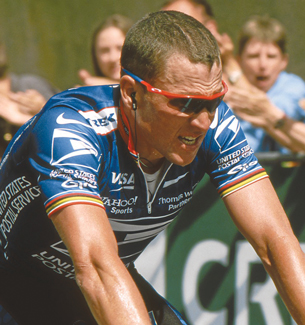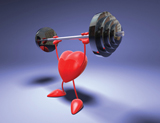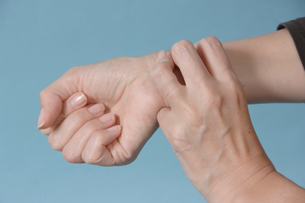Module 8 Intro
1. Module 8 Intro
1.13. Page 4
Module 8—Circulation, Immunity, and Excretion
 Read
Read
Heart Rate
Heart rate is the number of times your heart beats in a minute. Average resting heart rates are around 70 beats/min. On average, your heart (a fist-sized organ) will beat close to three billion times over a lifetime. More than 200 million litres of blood will pass through its chambers.

Courtesy of Benutzer Hase
World-class cyclists like Tour de France champion Lance Armstrong and Canadian olympic gold medallist Lori-Ann Muenzer are among the fittest athletes on the planet. They have incredibly low resting heart rates of 20 to 30 beats per minute. In order to meet the demands of their grueling sport, they need to have extremely powerful hearts. How do they achieve this?
Your heart is a muscle. As you learned in Module 6, muscles can be made stronger through repeated activity that stimulates the growth of muscle fibres. How can you strengthen your heart muscle? You can participate in activities that increase your heart rate such as running, aerobics, weight training, or any activity that increases cellular respiration rates (increased oxygen demands to provide energy from oxidizing glucose).
These activities will make the heart beat faster, meaning that it will relax and contract at quicker intervals to increase the rate of circulation. Cell demands for oxygen and rising levels of carbon dioxide also stimulate a faster heart rate as the body responds to a change in its environment. Meanwhile, the extra contraction of the heart serves to increase its strength and its overall efficiency.
This means that with each contraction, a stronger heart will move more blood. Think of an air mattress pump—if you push the pump weakly, it will take twice as much energy and pumping to fill up the air mattress. If you use strong pushes of the pump, the air mattress is filled more quickly and with less effort. In much the same way, a strong heart pumps more blood with each contraction. A strong heart does not have to contract as often in order to circulate blood. This results in a lower heart rate and a greater work capacity.

© Julien Tromeur/shutterstock
Due to intense cardiovascular training schedules, elite athletes such as Lance Armstrong work at creating the most efficient work output with the least amount of energy. They achieve such low resting heart rates due to the strength of muscle in their heart developed as a result of rigorous cardiovascular activities.
Read pages 275 and 276 of the textbook to learn more about the effects of exercise on the heart.
 Self-Check
Self-Check
SC 1. What is the relationship between heart rate and blood pressure?
 Self-Check Answer
Self-Check Answer
SC 1. High blood pressure is linked to people with elevated resting heart rates. The heart is not pumping efficiently, while the pressure is increased in the blood.
Blood pressure will increase slightly during exercise to accommodate the need for a faster rate of blood flow.
 Try This
Try This
TR 1. Heart Rate Recovery

© David Kneafsey/iStockphoto
How long does it take your heart to return to its resting rate? First find your pulse at your wrist or under your jawbone. Record your pulse for 15 seconds and multiply by 4. This is your resting heart rate. Now, do jumping jacks or another vigorous activity for 1 minute. Immediately take your heart rate at the end of your exercise. Continue taking measurements every minute until your heart rate has returned to your resting rate. Plot these results on a graph of heart rate versus time.
If you have a physical condition that makes it inadvisable to exercise vigorously, try this alternative. After recording your resting heart rate, sit quietly, breathe deeply, and relax your body. After 4 minutes, check your heart rate to see how much you have lowered it. Take readings for every minute until your heart rate returns to its resting rate. Plot these results on a graph of heart rate versus time.
Go to your Lesson 2 Assignment to record your results.